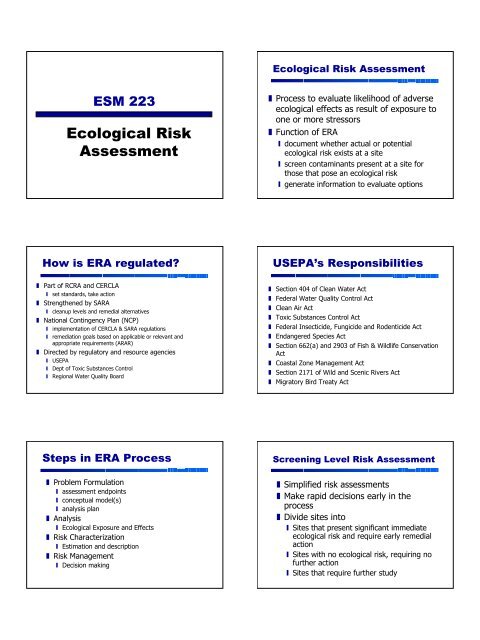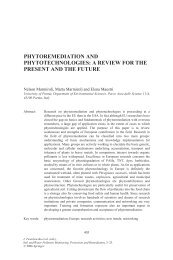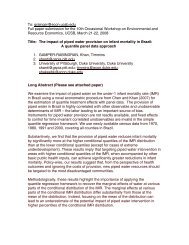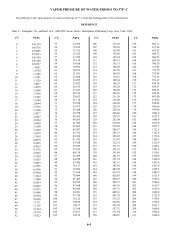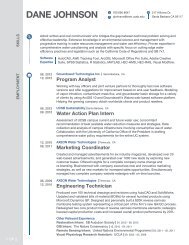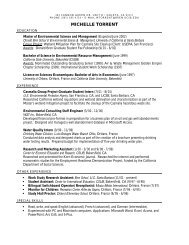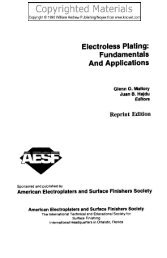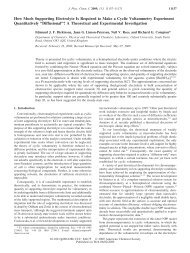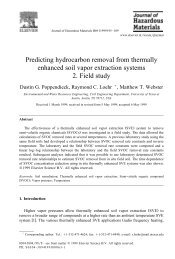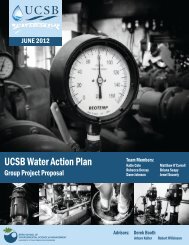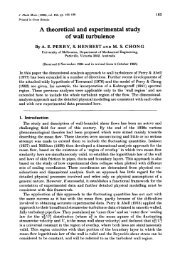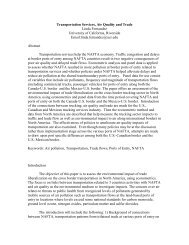Ecological Risk Assessment
Ecological Risk Assessment
Ecological Risk Assessment
You also want an ePaper? Increase the reach of your titles
YUMPU automatically turns print PDFs into web optimized ePapers that Google loves.
<strong>Ecological</strong> <strong>Risk</strong> <strong>Assessment</strong><br />
ESM 223<br />
<strong>Ecological</strong> <strong>Risk</strong><br />
<strong>Assessment</strong><br />
Process to evaluate likelihood of adverse<br />
ecological effects as result of exposure to<br />
one or more stressors<br />
Function of ERA<br />
document whether actual or potential<br />
ecological risk exists at a site<br />
screen contaminants present at a site for<br />
those that pose an ecological risk<br />
generate information to evaluate options<br />
How is ERA regulated<br />
USEPA’s Responsibilities<br />
Part of RCRA and CERCLA<br />
set standards, take action<br />
Strengthened by SARA<br />
cleanup levels and remedial alternatives<br />
National Contingency Plan (NCP)<br />
implementation of CERCLA & SARA regulations<br />
remediation goals based on applicable or relevant and<br />
appropriate requirements (ARAR)<br />
Directed by regulatory and resource agencies<br />
USEPA<br />
Dept of Toxic Substances Control<br />
Regional Water Quality Board<br />
Section 404 of Clean Water Act<br />
Federal Water Quality Control Act<br />
Clean Air Act<br />
Toxic Substances Control Act<br />
Federal Insecticide, Fungicide and Rodenticide Act<br />
Endangered Species Act<br />
Section 662(a) and 2903 of Fish & Wildlife Conservation<br />
Act<br />
Coastal Zone Management Act<br />
Section 2171 of Wild and Scenic Rivers Act<br />
Migratory Bird Treaty Act<br />
Steps in ERA Process<br />
Screening Level <strong>Risk</strong> <strong>Assessment</strong><br />
Problem Formulation<br />
assessment endpoints<br />
conceptual model(s)<br />
analysis plan<br />
Analysis<br />
<strong>Ecological</strong> Exposure and Effects<br />
<strong>Risk</strong> Characterization<br />
Estimation and description<br />
<strong>Risk</strong> Management<br />
Decision making<br />
Simplified risk assessments<br />
Make rapid decisions early in the<br />
process<br />
Divide sites into<br />
Sites that present significant immediate<br />
ecological risk and require early remedial<br />
action<br />
Sites with no ecological risk, requiring no<br />
further action<br />
Sites that require further study
Screening ERA<br />
Tools in an ERA<br />
For the screening level<br />
<strong>Assessment</strong> endpoints must be explicit<br />
Measurable endpoints must be a measurable<br />
ecological characteristic - related to<br />
assessment endpoint<br />
Determine whether exposure is or may be<br />
above the levels where adverse ecological<br />
effects might be expected<br />
Establish exposure pathways of concern<br />
Environmental Chemistry<br />
Determine contaminant fate and transport<br />
Literature-based ecotoxicological data<br />
NOAEL<br />
LOAEL<br />
Ecotox information sources<br />
AQUIRE Database<br />
PHYTOTOX Database<br />
Integrated <strong>Risk</strong> Information System (IRIS)<br />
Hazardous Substances Databank<br />
US FWS Contaminant Hazard Review<br />
ATSDR Toxicological Profiles<br />
Registry of Toxic Effects of Chemical<br />
Substances (RTECS)<br />
Screening Criteria<br />
Water<br />
USEPA Ambient Water Quality Criteria<br />
Water Quality Objectives (CRWQCB, 1986)<br />
Sediments<br />
Sediments Effects Range Data from NOOA (Long & Morgan,<br />
1991)<br />
Sediment Quality Objectives (CRWQCB, 1986)<br />
Washington State Marine Sediments Criteria (WDOE, 1991)<br />
Soils<br />
Quebec Soil Clean-up Criteria (QME, 1988)<br />
Dutch Soil Clean-up Act (Beyer, 1990)<br />
Criteria for Contaminated Soil/Sediment Cleanup (Fitchko, 1989)<br />
ERA Example<br />
NAWS at Point Mugu<br />
Effects of sediment contamination on<br />
organisms near the base<br />
Copper and PCBs are the main concern in this<br />
region<br />
Copper can be acutely or chronically toxic to<br />
various organisms<br />
PCBs bioaccumulate and bioconcentrate,<br />
producing reproductive impairment
Fox River Case Study<br />
Fox River Human Health and <strong>Ecological</strong><br />
<strong>Risk</strong> <strong>Assessment</strong><br />
Executive Summary<br />
Table of Contents<br />
Geographical Setting<br />
Details of ERA<br />
Fox River Case Study<br />
Highlights of Executive Summary<br />
Populations considered<br />
Recreational anglers<br />
Subsistence anglers<br />
Hunters<br />
Drinking water users<br />
Local residents<br />
Recreational water users<br />
Construction workers
Fox River Case Study<br />
Fox River Case Study<br />
Highlights of Executive Summary<br />
Fish contain PCBs<br />
Anglers can have Cancer <strong>Risk</strong>s (CR) up to 1.5<br />
x 10 -3<br />
Hazard Index up to 56<br />
Based on Fish Tissue data from 1990 (study<br />
conducted in 1999)<br />
Highlights of Executive Summary<br />
Potential population exposed<br />
Up to 47,000 recreational anglers<br />
About 2-5,000 subsistence anglers<br />
Cancer risk about the same in the four<br />
reaches considered<br />
Highest risk from carp, followed by perch,<br />
walleye and white bass<br />
Fox River Case Study<br />
Highlights of Executive Summary<br />
<strong>Risk</strong> to hunters ~ 10 -4 (PCB contaminated<br />
waterfowl)<br />
<strong>Risk</strong> to people drinking contaminated water<br />
~10-6 in most contaminated stretch – mostly<br />
from arsenic in water<br />
May require further sampling to determine if<br />
arsenic continues to be a concern<br />
This water is not directly used a drinking source<br />
Fox River Case Study<br />
Sources<br />
Fox River Case Study
Fox River Case Study<br />
Fox River Case Study<br />
Pollutant loading has decreased by 85%<br />
since 1970s<br />
Although PCBs not discharged directly, still<br />
estimated loading of 3-5 kg/year from<br />
landfills and other sources (very low<br />
concentrations)<br />
Non-point sources: eroded particles and<br />
contaminated sediments from small creeks<br />
Fox River Case Study<br />
Transport Processes<br />
Atmospheric transport: contributes 2-16 kg<br />
PCB/yr to Green Bay in snow and rain plus<br />
some dry deposition<br />
Sediment transport: primary mechanism for<br />
moving PCBs through the watershed and river<br />
Fox River contributes > 90% of PCB loading to<br />
Green Bay<br />
Concentrations in water ~50-100 ng/L<br />
Fox River Case Study<br />
Sediment concentrations (from 532<br />
samples!) range from 2 to 222 x 10 3<br />
µg/kg<br />
In Sediment Deposits A, C and POG, total<br />
PCB loading exceeds 50 x 10 3 µg/kg<br />
Reflect specific point sources discharging<br />
PCBs in this region<br />
Fox River Case Study<br />
PCBs in fish tissue have been as high as<br />
26 x 10 3 µg/kg tissue in carp (in 1976)<br />
Have generally dropped about an order of<br />
magnitude in more recent samples<br />
Tissues also contain dioxins, furans,<br />
pesticides (DDT, DDE, Dieldrin), mercury,<br />
lead and arsenic …<br />
See Figures 2.1 to 2.20 in report<br />
Fox River Case Study<br />
Where does the data come to do the risk<br />
assessment
Fox River Case Study<br />
Human Health <strong>Risk</strong> Analysis<br />
Fox River Case Study
Fox River Case Study
Fox River Case Study<br />
<strong>Ecological</strong> <strong>Risk</strong> Analysis
Fox River Case Study<br />
Fox River Case Study<br />
Fox River Case Study<br />
Fox River Case Study
Fox River Case Study<br />
Fox River Case Study<br />
Fox River Case Study


